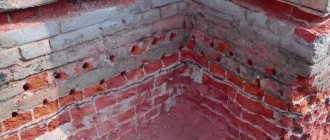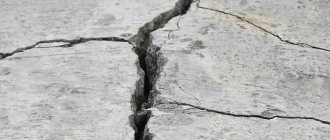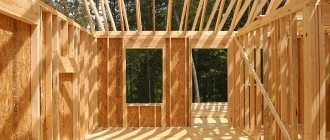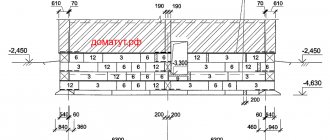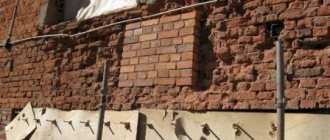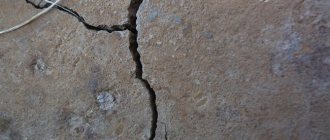There are a huge number of reasons leading to the appearance of cracks in brick houses. This includes unexpected seismic activity, mechanical damage, and errors made during construction. For example, cracks can occur due to incorrect lining of the brickwork of the load-bearing walls of the house. What to do if a crack in the wall of a brick house has already appeared? In any case, the house will need both superficial, cosmetic and thorough repairs to eliminate the causes of damage if they appeared due to violations of construction technology. If you do not strengthen the base and walls of the house in time, then one small gap can provoke a distortion of the supporting structure and irreversible deformation of the house.
How and how to repair cracks in the walls of a brick house: causes and repairs
We usually perceive the catchphrase “life has cracked” as a joke.
However, humor is not appropriate when cracks appear on the walls of a private house, signaling a violation of the bearing capacity of the foundation.
It is difficult for the average citizen to understand what to do with cracks in a brick house. Only an experienced builder can reliably establish the cause of their occurrence and give practical advice on how to eliminate them.
What causes cracks in the walls of a building? We will talk about this difficult topic in detail.
Fixation methods
This applies to cases where large vertical cracks of large sizes, more than a centimeter, appear on the masonry. Cement alone is not enough; a strong metal screed is needed. Fixation and repair options:
- Special anchors. The method involves driving anchors into metal dowels, which must be installed in advance along the edges of each crack.
- Longitudinal metal brackets are mounted and bent at the edges. Before the process itself, you need to create several holes in each wall (When the work is finished, all the holes will be filled with cement mortar). The method is reliable, it is possible to fix even through cracks in thick walls.
Fixation method - You can strengthen the masonry with special elements. This is done from the inside; for this you need to install several fasteners on the surface itself. Next, they are inserted to a sufficient depth, usually at least half of the wall itself. Each fastener can be alternated.
- Reinforcing mesh is an option for rationally strengthening brickwork of any size. It is possible to strengthen not only a certain part of the wall, but the entire surface. The option with reinforcing mesh is suitable for deep crevices and cracks.
Reinforcement mesh
Classification and causes of crack formation
The emergence of durable and technologically advanced Portland cement revolutionized the construction industry. However, from the point of view of the risk of cracking, the new binder has one significant drawback - a high hardening rate.
As you know, after construction, a building does not immediately occupy a stable place in the soil mass. The process of natural shrinkage continues for several years. Cement mortar, on the contrary, gains strength very quickly. Such a large difference between the decay time of sedimentary deformations and the active strength gain of Portland cement leads to the appearance of cracks that break the masonry mass.
With lime mortar things are simpler. It hardens slowly, so when the foundation settles, through voids in the walls usually arise. That is why in buildings that have stood for centuries we see much fewer cracks than in modern high-speed new buildings.
Experts classify cracks in brickwork according to the following criteria:
- Reason for formation: structural, deformation, shrinkage, temperature, wear;
- Type of destruction: rupture, crushing, shearing;
- Direction: horizontal, vertical, oblique;
- Outline: curved, straight, closed (does not reach the edge of the wall).
- Depth: through, superficial;
- Danger level: not dangerous, dangerous;
- Time: stabilized, not stabilized.
- Size of opening: hairline (up to 0.1 mm), small (up to 0.3 mm), developed (0.4–0.8 mm), large (1 mm or more).
There are many reasons why a house cracks:
1. Soil settlement . It can be caused by uneven compressibility of the soil (dense and weak areas), uneven loading of the foundation, leakage of tap and sewer water into the ground. It leads to the appearance of inclined splits reaching the edge of the wall or the development of vertical (oblique) cracks in the middle part of the facade.
2. Freezing and thawing of the soil . Freezing of heaving soils causes uneven rise of the foundation (if its base is located above the freezing point of the soil). This process is especially dangerous for a building under construction, the weight of the walls of which is small (low flexural rigidity). In this case, many cracks form on the walls. When the soil thaws in spring, the reverse process occurs—the foundation settles. The walls are receiving new damage.
3. Repair of a crack in the wall may be necessary after the addition of a new room . This causes additional compressive stresses to develop in the foundation soil, leading to settlement of the foundation. As a result, inclined cracks appear in the adjacent walls of the existing building (open upward).
4. Uneven loads on the foundation within the same building . In modern houses, long glazed walls often alternate with blind areas. The difference in load leads to uneven settlement of the foundation.
5. Digging a pit next to the building . If the house stands on the slope of a pit or close to it, then the sliding of the soil affects the foundation and inclined cracks appear in the brick walls on the side of the pit.
6. Influence of neighboring foundations . Stress zones are superimposed, increasing soil compression and settlement.
7. Surface loads . When storing a large amount of building materials next to a building under construction, additional stresses appear in the ground. They can cause significant foundation settlement and cracks.
8. Dynamic influences . As a result of driving piles, the constant movement of heavy vehicles, and the operation of compressors, sandy soils are compacted and clay soils are softened. As a result, the foundation gets settled and the walls get cracks.
9. Temperature deformations . Causes the formation of cracks in the middle part of the walls (vertical direction). Repairing cracks in brick walls is most often required for long buildings that do not have expansion joints.
10. Overloading of masonry . They appear in walls and on pillars. A characteristic feature of crush cracks is closedness and a vertical direction. They are very dangerous because they can cause a sudden collapse of one pier, followed by a chain reaction of the collapse of all the others.
11. Shrinkage deformations (non-hazardous) . Observed on plastered walls (cracks are small, randomly scattered, closed, do not reach the edge of the wall). The reason for their appearance is the shrinkage of too greasy plaster mortar.
The non-hazardous category also includes vertical straight cracks with a constant opening along their length. They are localized at the junction of walls (old and new).
Types of defects
Building brick is a common material used for the construction of internal and external walls. It is considered durable, strong, and lasts for decades.
Perhaps somewhere the load on the walls has increased or these are the consequences of man-made circumstances
In any case, you need to carefully examine the entire surface of the wall that has cracked, paying attention to the direction and width of the chip.
Under a strong vertical load, the crack will expand downward, and if the problem is in the foundation (sagging, groundwater has washed away, mistakes were made in construction), then the crack will expand upward. If the material has become unusable, then a fine network of cracks will be located closer to the surface.
Cracks are divided into the following types:
- Vertical.
- Horizontal.
- Narrow (up to 5 mm).
- Wide (more than 1 cm).
- Superficial.
- Deep.
- Medium (5-10 mm)
- Inclined.
- Direct.
- Closed.
- Through.
- Curvilinear, etc.
The listed types are clearly visible upon visual inspection; they can be located both on the external facade of the building and on the inside of the house. The size of the defect can be easily determined using a construction tape.
Small chips can be quickly fixed with your own hands using sealants, concrete mortar or injection. For very large gaps, professional intervention and replacement of the damaged area will be required.
Wide cracks with dimensions greater than 1 cm are considered critical defects that require elimination by special repair methods.
How to repair cracks in brick walls?
It is possible to answer the question of how to repair a crack in the wall of a brick house only after identifying the cause of its formation and stabilizing the settling process.
To control cracks, gypsum domes are used, which are placed directly in the zone of their development. If the brittle gypsum does not burst within a certain time, we can talk about the cessation of the cracking process and begin to eliminate it.
You can cover the crack with strong cement mortar and limit it to this in the case when it is small (up to 5 mm), not through and does not increase in size.
Brick locks are used to repair wide cracks. To do this, cracked bricks are removed from the masonry mass on the outer and inner sides of the wall, and a new one is placed in their place on the mortar.
An improved version of this solution is the insertion of a metal anchor (a powerful plate with two pins). It is placed on the side in which the crack develops (upward expansion - the anchor is on top, downward expansion - the anchor plate is placed below).
Two steel plates with tension bolts passed through the wall are placed on through cracks. An alternative option is to hammer steel brackets into the masonry on both sides of the wall.
If a crack occurs in the area where the floor slab rests on the wall (insufficient area of the support area), then a channel is placed under the slab. On the other side, a steel plate is placed on the wall and fastened with coupling bolts.
When cracks appear in the brick walls of the external walls, steel clips are used. Their size and design depend on the width of the wall.
All described repair options can be seen in the figure.
When cracks appear that threaten the integrity of the house, more radical measures have to be taken. They consist of installing steel rods on the outside and inside of the wall, covering the entire building in a powerful steel bandage.
To summarize what has been said, we note that the condition of a brick and block house (especially a new one) must be closely monitored. The sooner cracks are detected, the less money and time it will take to eliminate them.
Strengthening the foundation
Serious problems with structural integrity require a total rebuild of the foundation:
Strengthening the foundation of the house
- The first step is to make a deep trench along the wall with a crack to the level of the base horizon. The width of the trench should not be greater than the thickness of the foundation.
- After this, the crack needs to be widened a little, cleaned of weakly reinforced stones and the cement that adheres them.
- The expanded and cleaned area is drilled horizontally and vertically for reinforcement. It is necessary to intertwine reinforcing bars of suitable size with anchors and secure them by welding. The distance between the rods depends on how wide the crack needs to be repaired. This reinforcement is made as a further connection with the skeleton of the new reinforcing foundation.
- Now you can make formwork and pour concrete into it. To prevent new cracks, all work on the base is carried out only after it has dried. You can also spray it with water occasionally to help it cure evenly.
The solution will take a very long time to dry - at least a month, only after this time can the site be compacted and a blind area made.
These measures will stop the destruction of the walls and only after they have been carried out can we begin to directly eliminate the defects.
Repairing cracks in brick walls
Many people know the expression of the famous poet Faina Ranevskaya that after a few years life gives cracks, which will grow over time if they are not patched up in time. So it is with a residential building, if a split or small crack appears on the load-bearing wall, then it is urgently necessary to solve this problem.
Crack in a brick wall
First of all, you need to consult with a professional builder, because a person who does not have even a minimal level of knowledge in the field of foundation construction and repair will find it very difficult to understand how to get rid of this problem once and for all.
Why does brick crack and how can you repair cracks in a brick wall, as well as in similar brickwork ? These questions need to be examined from many angles. So let's get started.
Types and causes of crack formation
cause of wall cracking
Today, construction companies offer revolutionary, strong and durable Portland cement, which has revolutionized construction materials. It is distinguished not only by its durability, but also by its instant hardening speed, which is perhaps its main advantage among its competitors in the field of reinforcing materials.
All experienced builders know that immediately after construction, the building does not immediately take its place firmly and for a long time in the main foundation, this process takes about five to ten years, and the cement mortar, on the contrary, very quickly gains its strength. Such a very large difference between the subsidence time and settlement of the house can lead to the appearance of cracks and large splits, which will intensively tear apart the mass of load-bearing masonry.
Well, as for the solution of lime with the addition of sand, things are much simpler. It hardens quite slowly and when settlement of the foundation itself begins, empty or through voids should not appear in the walls. This strengthening technology is mainly used exclusively for the construction of new houses according to today's standard, and as time shows, in new buildings there are no problems with cracks and settlement of the foundation for a long time.
Builders - specialists divide cracks among themselves in brickwork according to the following criteria:
- What causes them to appear: deformation of the house structure, shrinkage or temperature wear of a residential building;
- External and internal view of the destruction itself on the wall: Split, rupture, cut;
- Direction of destruction: horizontal, vertical, inclined at various angles;
- Shape: curved, straight, closed or broken in half (that is, it almost does not reach the edge of the load-bearing wall).
- Size and depth: on the surface of the wall and inside it;
- How complex the repair work is, what is the risk of wall destruction: dangerous and non-hazardous;
- Time since destruction: stable or unstable;
- Size of the opening of the split or crack itself: microscopic (up to one millimeter), small (up to three millimeters), medium (from four to eight millimeters), large (more than ten millimeters), very large (from fifteen millimeters or more).
plants split the wall
Several main reasons for the appearance of such destruction on the wall, of which there are quite a lot:
- Settlement or destruction of the soil itself. This problem can be caused by uneven natural burning of the soil (its strong and weak sections), incorrect and unacceptable load of the main foundation, leakage of a very large amount of waste water, as well as contaminated water, into the soil. It is these reasons that can lead to the appearance of large indirect splits or to the formation of vertical cracks that can reach right up to the edge of the load-bearing wall, and so on.
- The soil on which the house stands is very hardened. This phenomenon can be caused by severe frosts, which can cause uneven lifting of the foundation. In particular, soil hardening is very dangerous for an unfinished building, the walls of which have not yet hardened and have not acquired the necessary stability. In this particular case, uneven and deep cracks may form near the walls, and when the soil begins to melt after winter, the opposite process may most likely occur - settlement of the foundation, which can lead to new damage to the load-bearing walls.
- New repairs to a load-bearing wall may be needed after a small building or room has been added, as the foundation may not be able to support the new, additional weight and may settle.
- Uneven and inconsistent loads on the foundation of the house. For example, if a house is built in the Art Nouveau style, then luxurious and long glazing (which is very often used in this architectural style) can quite often alternate with small blind areas of the house, which will lead to a large difference in weight and ground settlement.
- If the pit is located next to a building, then very high temperature conditions also have a detrimental effect on the soil, which in the future can lead not only to sedimentation of the soil, but also to its excessive looseness. It is for these reasons that medium-sized cracks can form on the walls.
- Extra load due to neighboring houses. On a common foundation, the zones of greatest stress are superimposed on each other and allow the soil to settle very strongly.
- The reasons may lie not only in the soil itself, but also above it. For example, collecting heavy building material in large quantities next to an unfinished building and already in the ground itself, additional loads and stresses can appear, and they can cause very strong external settlement of the foundation and the appearance of large cracks and splits.
- Constant impacts on the foundation. For example, if you are driving piles on the territory of a residential building, you are constantly moving heavy vehicles, compressors are running - all this leads to the sinking of sandy soil and a strong softening of clay masses in the soil. The combination of all these factors can result in soil settlement and cracks in load-bearing walls.
- High temperatures can cause vertical cracks and splits in the walls of your home. Repairing cracks in masonry is mainly required for longer buildings that do not have expansion joints.
- Overloading of brickwork. In this case, cracks may appear between the walls and on the pillars. Such cracks can be identified by the characteristic closedness and verticality of their direction. Overload of masonry. They appear in walls and on pillars. A characteristic feature of crush cracks is closedness and a vertical direction.
- Various non-hazardous shrinkage deformations can be observed on the plastered walls of a house - these can be small or small cracks that are very randomly scattered over the entire area of the wall and are mostly closed, and the most important thing is that they do not reach the edge of the wall. They appear due to shrinkage of an overly thick plaster mortar.
Crack sealing technology
There are many ways to repair a crack in brickwork:
- You can install a brick lock or a lock with an anchor;
- Reinforcement of walls using tension bolts;
- Repairing a through crack with steel staples;
- Carry out repair work in the area where the floor slab is unlocked;
- Strengthen the cracked wall;
- Make an overlay from hardened steel;
- Install special brackets
- Install the floor slab;
- Cover the wall with a finishing layer.
Watch this video for more details:
